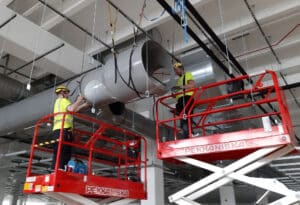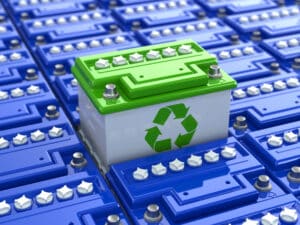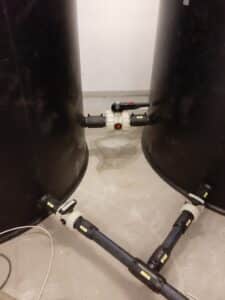The purpose of the project was to replace a metal container by three plastic containers storing Sodium Hydroxide (NaOH). The NaOH was used in this case as a pH control agent in a wastewater treatment application. Apart from this, the concentration of the solution was increased from an initial 20% to a 50%, in order to reduce costs during the future treatment process.

CHEMICAL AND MATERIAL SELECTION
Sodium Hydroxide (NaOH), also known as caustic soda or lye, is a common inorganic compound that is typically used as a strong chemical base. It is known to be very corrosive for metals-tissues and toxic when ingested. Besides, its solution is ”slippery”, meaning that will try to find a path to leak.
The use of PE100 high-density linear polyethylene (HDPE) storage containers and pipelines is one of the most cost-effective variants that is able to offer a potential 10+ year of service life (at room temperature). Thanks to its chemical resistance and good mechanical properties, HDPE can store and transport NaOH solutions. A secondary tank in place is always required for safety reasons.
DESIGN
All the tanks needed to be installed in an interior place to avoid freezing point of a 50% solution of NaOH. Low temperatures, starting at +15ºC, can cause the crystallization of the caustic soda.
The main goal was to ease the connection between the source of the NaOH solution and the actual process where it would be used. The tanks were placed next to the road, so they could be easily loaded from the truck and, at the same time, close to the water cleaning system.

Containers design and dimensioning strictly followed the DVS standards to fulfil the mechanical and chemical requirements.
The pipeline installation had to ensure 4 basic functions:
- Input of chemical to the first tank.
- Communication between tanks to fill them all when loading.
- Transport from the storage to the process.
- Ventilation of the tanks.
Pipe dimensions and thickness were defined according to DVS standards. The pipelines path was determined to avoid extra materials and ease the installation. Transform the pipeline idea into a drawing that everybody can understand is a critical step in this stage. Thanks to 3D modelling, Atolli engineering team could have a fluent communication with the clients. Through computer simulation, it was ensured the storage capability and the mechanical resistance for both tanks and pipes.
QUALITY PRODUCTS
Atolli Oy is a Finnish service company and wholesaler specialized in plastics for industry and construction. During almost 30 years, Atolli has focused on the supply of technical plastics, construction plastics, plastic piping and plastic welding equipment in Finland, the Nordic countries, and the Baltics. The key points have always been product quality, fast and punctual delivery.

Atolli pipes and fittings are manufactured by some of the most renowned corporations in the plastic pipeline market. Their reputation in the manipulation and production of plastic materials, along with the advanced plastic processing techniques, allows Atolli to provide components with excellent repeatability.
VALVES
Materials used for the valves in this installation were PP-H and U-PVC.
Polypropylene (PP) is thermoplastic similar to HDPE, with higher stiffness, strength and hardness levels. It offers a very good chemical resistance to NaOH at room temperature.
Polyvinyl Chloride (PVC) is a very common polymer that offers good relation between density and mechanical properties. It can be made more flexible by adding plasticizers. If no plasticizers are added, it is known as unplasticized polyvinyl chloride (UPVC). It also has good resistance to NaOH at room temperature.
EPDM valve seals were chosen because of their chemical resistance to NaOH at the specified temperature and pressure.
There are many types of plastic valves, each one with a specific range of applications that enhance its properties. The main role of the valves in this project was to shut off the flow, basically for maintenance operations. Therefore, manual ball valves were used in this case. They provide very tight shut-offs, with simple closing mechanisms. That has allowed Atolli to dramatically reduce the price of the materials while keeping the functionality of the system. All the valves meet the performance specifications and are equipped with easy maintenance connection types. All of them were supplied by FIP, a valve manufacturer leader with more than 60 years of experience.

INSTALLATION
The installation was run by one of Atolli’s installation teams. The joining of all the plastic components always depends on a range of parameters, such as joining time, temperature or pressure. Atolli welders carry on years of experience, they have all been trained and tested by external institutions. For this reason, they know the perfect parameters for each welding procedure.

On this project, the main welding method was electrofusion, which ensures an accurate and error-free welding. This method uses special fittings that have built-in electric heating elements which are used to weld the joint together.






